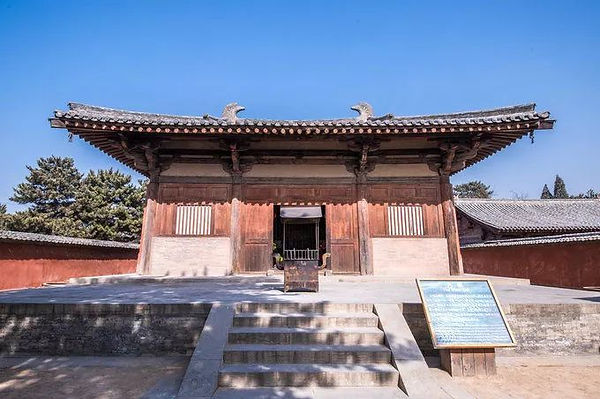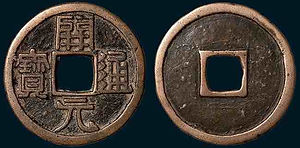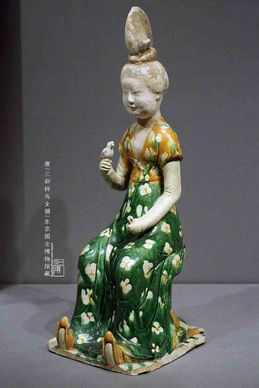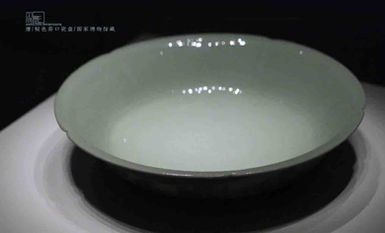Tang Dynasty — Epoch of Opulence and Splendor in Chinese History
The Tang Dynasty (618 — 907) stands as one of the most prosperous empires in Chinese history, marked by a series of great reigns during which culture, economy, science, poetry, art, and technology flourished.
Inheriting valuable legacies from the preceding flourishing Sui Dynasty (581 — 618), the Tang Empire expanded even further, ushering in a golden age in history.
The Tang Dynasty lasted for 289 years and was ruled by 21 emperors.

Unearthed Food (Dumplings and Desserts) and Utensils of Tang — National Museum of China (Photo by Kanjianji)
Brief History of the Rise and Fall of the Tang Dynasty
Political Structure and Social Systems of the Tang Empire
Tang Dynasty Achievements in Science and Technology

Building Complex of Daming Palace, the Royal Palace of the Tang Dynasty, Based on Architectural Historian Yang Hongxun's Restored Model.
Facts About the Tang Dynasty
-
The founder of the Tang, Li Yuan, was a cousin of Emperor Yang of Sui (the last emperor of the previous Sui Dynasty).
Initially, he only controlled one city with around 30000 soldiers that he recruited by himself and his family.
Some of his sons and daughters are excellent generals who defeated and unified the nation alone.
-
The writer of Tao Te Ching and the founder of Taoism, Li Er (also honored as Lao Zi or Lao Tzu), was respected as the ancestor of the Tang royal family.
Therefore, the Taoism philosophy was highly respected by the ruling class, and the Taoism Religion was the national religion of Tang.

Golden Dragons (Zou Long) that Were Used as Ritual Implements of Taoism Religion Ceremony in Tang — Shaanxi History Museum (Photo by Dongmaiying)
-
The Imperial Examination was completed and widely applied by the only female emperor in Chinese history, Wu Zetian.
She selected and empowered more talented commoners to balance strong, old noble clans.
The system was inherited and well developed since then, allowing talented people, regardless of origin and social status, to get involved in the ruling class and obtain power.
-
Clans that obtained political powers were forbidden to get involved in industry and commerce, so they couldn’t use their power and privilege to gain profit through unfair competition with commoners.

Inlaying Gold Ruler of Tang — National Museum of China (Photo by Dongmaiying)
-
The capital city of Tang Chang'an (now named Xi’an) was the biggest in the world during that period.
Chang'an was about 87 square kilometers (approximately 33.59 square miles), with 110 districts and over 1.5 million population.
Compared to big cities in the same era, Chang'an was seven times bigger than Constantinople and 6.2 times bigger than Baghdad.
This fabulous city had been occupied six times by rebellions during the entire Tang Dynasty and was destroyed by Zhu Wen before the empire ended.
-
The leader of the most destructive rebellion army that heavily jeopardized the empire in late Tang had participated in the Imperial Examination but failed.
Then he started to rebel and fought against the Tang army.
The terminator Zhu Wen, who destroyed the Fabulous capital city Chang'an, was from this rebel army.

Restored Picture of Part of the Chang'an City of Tang
-
Tang was a golden age of Chinese Poetry and had the best poets and poems in history, many of which are still popular today.
-
Many famous civil officials were also excellent at military and martial arts; great poets and artists, like Yan Zhenqing and Li Bai, were also brave and excellent warriors.
-
The turning point of Tang was an eight-year-long rebel war that happened during the reign of Emperor Li Longji, the An-Shi Rebellion.
Around 36 million people were dead during this war.
After this war, many solid and half-independent regimes were formed and kept growing.
-
In the late Tang, the eunuch group obtained military power for the first and only time in Chinese history, allowing them to abrogate and enthrone emperors.

Silver Tea Set (Cha Long) of Tang — Shaanxi History Museum (Photo by Dongmaiying)
-
Night Market appeared and became famous.
-
The earliest record of the takeout service was in the Tang Dynasty.
-
Polo and Tug-of-War were popular sports in Tang. Empress Wu Zetian was very good at Polo.
-
Incense was widely used.
-
Women could dress up as men, and low-cut blouses were quite popular during the Tang era.
-
Men could wear flowers in their hair, both royals and commoners.
Figurines Made During Tang Era (Photo by Dongmaiying)
-
Many foreigners participated in the Imperial Examination and became political or military officials; some even made very high ranks, like the minister or marshal.
More importantly, they didn’t need to change their nationality to Tang.
-
Application of the international law.
When two foreigners disputed, if they were from the same country, then applied their laws; if they came from different countries, then they should follow the Law of the Tang.
-
Nestorianism was disseminated and got many believers.

Brocade Embroidery of Tang — Datang Xishi Museum (Photo by Dongmaiying)
Brief History of the Rise and Fall of the Tang Dynasty
Chaotic Era and Warfare Among Warlords
In the later years of the Sui Dynasty, since 611, many peasant uprising armies and warlords from powerful aristocratic clans kept fighting against Sui’s troops.
Meanwhile, the former complied Turkic Khaganate started to expand its territory, and their Khan claimed himself as the most honorable king again.
Therefore, most of those warlords who wanted Khan’s support complied and respected Khan as their monarch.
In the year 617, a warlord named Li Yuan, who came from a powerful military clan, claimed he would try his best to bring peace to the country.

Unearthed Tri-coloured Glazed Pottery Horse (Tang San Cai) of Tang — Asian Art Museum of San Francisco (Photo by Dongmaiying)
Rise of the Tang Dynasty
From only one city, Taiyuan, Li Yuan's territory was largely and rapidly expanded thanks to his talented sons and generals.
Then, Li Yuan, Emperor Yang Guang's cousin, occupied the capital city and respected Emperor Yang Guang's grandson as emperor.
The following year, after hearing that Emperor Yang Guang had been assassinated, Li Yuan took the throne and named his new dynasty Tang.
A new chapter began with the Tang Empire, marking another era of unity and glory in China.
Agriculture, economy, art, and science thrived at advanced levels, accompanied by frequent cultural exchanges and flourishing international trade through the Silk Road and maritime routes.

Gilding Silver Cup of Tang — Metropolitan Museum of Art (Photo by Dongmaiying)
Expansion of Tang Empire Led by Genius Li Shimin
In the next five years, Tang’s army defeated other strong uprising forces and unified the nation.
At the same time, the Empire Turkic Khaganate became super large and aggressive and planned to occupy Tang’s land.
Besides those brave warriors, an important reason the early Tang army could achieve such extraordinary success in such a short time was that they had an excellent chief commander.
This military genius was the second son of Emperor Li Yuan, named Li Shimin.
He suggested his father rebel; he led Tang’s army to win countless decisive wars and gained a good reputation among civilians.

Sculpture Stone Horses in Li Shimin's Mausoleum (Zhao Ling), War Horses of His Six Important Wars.
Their Names Are Te Le Biao, Qing Zhui, Shi Fa Chi, Bai Ti Wu, Quan Mao Guan, Sa Lu Zi.
The Last Two Are In Penn Museum, The Rest Are in the Forest of Stone Steles Museum of Xi'an.
Prosperity Under Reign of Tang Taizong
In 626, Li Shimin ambushed his big brother, the crown prince.
Afterward, his father, Li Yuan, nominated him as the crown prince and soon abdicated the throne.
Emperor Li Shimin, also respected as Tang Taizong of Emperor Taizong of Tang, started his 23-year-long reign.
He defeated his biggest enemy, the Empire Turkic Khaganate, vastly extended the territory, and brought wealthy and stable lives to his people.
After he departed, he left the prosperous Tang to his ninth son, Li Zhi, another excellent sovereign who flourished the empire further.

Tang Taizong or Emperor Taizong Receiving the Tibetan (Tu Bo) Envoy, Painted by Politician/Artist Yan Liben (601 — 673) — Palace Museum
Wu Zetian The Only Female Emperor of China and Her Governance
However, Emperor Li Zhi’s queen was his late father’s imperial concubine, the ambitious Wu Zetian.
After Emperor Li Zhi passed away, her two sons ascended to the throne but were both abolished by Wu.
Later, Wu claimed the throne and changed the name of the empire to Zhou, becoming the only female emperor in the history of China.
Under her governance, everything developed well.
In her late years, some political conflicts became quite severe among her sons, her lovers, her daughters, and some of her grandchildren.
In the end, one of her grandsons won the throne and became another controversial monarch.

Gold Card Unearthed in the Mount Song, Writing that Emperor Wu Zetian Prays for the Forgiveness from Deities about All the Sins that She had Committed — Henan Museum (Photo by Dongmaiying)
Prime FlourProsperity and Destructive Turning Point
This was Emperor Li Longji, also respected as Emperor Xuanzong of Tang or Tang Ming Huang.
The Tang Empire reached its peak under his reign.
Today, people can still see civilians' wealthy and comfortable lives during that period in masterpieces of great poets such as Li Bai, Du Fu, and Wang Wei.
In Emperor Li Longji's later years, he was fond of a beautiful woman Yang Yuhuan, and spent most of his life enjoying life with her.
As excellent musicians, they significantly contributed to ancient Chinese music.

Jade Flying Deity of Tang — Shanghai Museum (Photo by Dongmaiying)
Soon, the unjust An-Shi Rebellion War (755 — 763), also called An Lushan Rebellion, outburst in the north lasted eight years and caused around 36 million deaths.
This was the turning point of the Tang Dynasty.
Great Marshal Guo Ziyi, supported by loyal and talented generals such as Zhang Xun and Yan Zhenqing, led the Tang army to defeat the rebel troops, reclaiming lost territory with the collective efforts of numerous courageous warriors and civilians.

Yan Zhenqing's Calligraphy Draft to Memorize His Heroically Sacrificed nephew Yan Jiming (Ji Zhi Wen Gao), Recorded Brave Soldiers of Tang and the Intense Fights in the An-Shi Rebellion — Taipei Museum
Emerging Warlords and Struggling Emperors of the Tang Dynasty
Emperor Li Longji’s great-grandson, Emperor Li Kuo, was the last generation to witness splendid prosperity and cruel destruction.
He tried his best to recover the flourishing empire he had seen, but he failed and became a sovereign who made a series of self-contradiction policies.
An important reason for Emperor Li Kuo’s failure was the powerful, half-independent warlords.
During the An-Shi Rebellion War, many loyal generals vastly expanded their armies to defeat the enemies and made significant contributions.
After the war, therefore, those warlords were still loyal to the royal family of Tang, but they also tried their best to maintain their army and power.

Golden Deer Decoration of Tang — Qinghai Museum (Photo by Dongmaiying)
Recovery of Prosperity
Emperor Li Kuo failed in his dreams but secretly left a solid army to his beloved grandson Li Chun.
Under Emperor Li Chun’s brilliant leadership, this army defeated many misbehaving or rebellious warlords and took back the centralized power.
However, the following few emperors paid more attention to having fun and enjoying their lives, which gave the eunuch group a great deal of military power, who enthroned, abolished, and even imprisoned some emperors.
After Emperor Li Yan had ascended to the throne, he decisively took power back from eunuch groups after brutal fights and empowered intelligent officials.
Then the double-faced Emperor Li Chen further flourished the empire and brought the last prosperous era of the Tang.

Nanchan Temple of Tang in Mount Wutai, Rebuilt in the Year 782, Photo from qyer.
Disintegration and End of the Tang Dynasty
Two emperors afterward were quite incapable and lost power to the eunuch group again.
In the central government, the eunuchs and civil officials fought over authority, while uprising peasants and some warlords started to rebel on the borders.
When Emperor Li Ye ascended to the throne, the empire fell apart. He was ambitious and brave and tried to fight against the eunuch group and the disrespectful warlords.
However, he failed.
The fabulous capital city of Chang'an was destroyed. Emperor Li Ye and his entire family were assassinated by warlord Zhu Wen, except for a baby boy secretly sent away.
The Tang Empire was officially ended.
Those warlords built their independent kingdoms and claimed themselves kings; the nation then fell into another era of separation, the Five Dynasties and Ten Kingdoms.

Unearthed Copper Mirror of Tang — Shanxi Museum (Photo by Dongmaiying)
Political Structure and Social Systems of the Tang Empire
Population
At its zenith, the population of the Tang Dynasty is estimated to have reached approximately 80 million.
Political System: Three Departments and Six Ministries
The Three Departments operated independently and reported directly to the Tang emperors:
-
Department of Imperial Secretariats: Responsible for drafting and publishing decrees.
-
Department of Chancellors: Tasked with reviewing decrees by Imperial Censors.
-
Department of Imperial Affairs: The highest authority in state administration, responsible for executing decrees.
Subordinate to the Department of Imperial Affairs are the Six Ministries:
-
Ministry of Personnel: Responsible for the appointment, assessment, and removal of officers.
-
Ministry of Revenue: Manages household registration, finance, and taxation.
-
Ministry of Rites: Oversees ceremony and education.
-
Ministry of National Defense: Handles military affairs.
-
Ministry of Justice: Manages law, judiciary, and punishment.
-
Ministry of Constructions: Responsible for the design and implementation of national constructions.

Epitaph from mausoleum of Yuan Gongyu, Wrote by Remarkable Prime Minister Di Renjie of Tang — Qian Tang Zhi Zhai Museum in Luoyang City (Photo by Dongmaiying)
Official Selection System
The Tang Dynasty primarily implemented the Imperial Examination system, which facilitated the recruitment of individuals based on their talent rather than social class origin, enabling them to ascend to the ruling class through examinations and civil service.
Emperor Wu Zetian added the subject of martial arts to the Imperial Examination. Many excellent soldiers and generals, such as the remarkable General Guo Ziyi, were selected and promoted.

Jade Cup of Tang Carved with Lonicera Japonica Pattern — Shaanxi History Museum (Photo by Dongmaiying)
Tax System in Early and Middle Tang
-
Upon reaching adulthood, typically at the age of 20, every citizen would be allocated a specific amount of farmland.
-
Civilians were required to pay fixed quantities of farm and textile products annually as taxes and contribute to free labor services for the government, usually amounting to 20 to 30 days each year.
-
Individuals aged 50 and above were exempted from specific types of labor and taxes.
-
Occasionally, individuals had the option to pay money or provide products to gain exemption from certain taxes or services.
-
The number of labor days and tax amounts varied each year, based on factors such as the harvest situation, natural weather conditions, wars, and other events.
Reformed Semiannual Tax System
However, the destructive An-Shi Rebellion War caused irreversible chaos, death, and the complete breakdown of the old taxation system's feasibility.
Starting in the year 780, as a response to the significant chaos and destruction caused by the An-Shi Rebellion War, a simplified tax system was implemented:
-
Civilians paid taxes in money twice a year, once in summer and once in autumn, rather than through farmland products and labor forces.
-
They paid taxes based on the number of their land and property, as opposed to capitation.


Unearthed Copper and Gold Currency of Tang
Land System
People were allocated two types of farmland based on their social status, usually upon reaching the age of 20.
-
The first type of land was meant to be cultivated while individuals paid a certain amount in taxes and provided labor services. Upon the person's passing, the land was to be returned to the country.
-
The second type of land was privatized, allowing individuals to sell, cultivate, or bequeath it to others.

Agate Tea Cup (Zhan Tuo) of Tang — National Museum of China (Photo by Dongmaiying)
Military Service
-
Soldiers and their families were assigned farmland and allowed to reside together.
They were exempt from taxes and free labor services but were required to provide their own weapons and food.
They cultivated their land during periods of peace and fought on the battlefield during wars.
Even in times of peace, they were required to fulfill military service each year, with the duration varying at different times.
-
Since the middle of the Tang Dynasty (around 749), the recruitment of professional soldiers became the primary system, although it had appeared and been used as a supplementary means for nearly a thousand years.
Recruited professional soldiers, paid by the government, had their salary, clothes, etc., covered.

Unearthed Painted Pottery Figurines of Taming A Horse in the Tang — Luoyang Museum (Photo by Dongmaiying)
Tang Dynasty Achievements in Science and Technology
-
Wide utilization of Woodblock Printing.
-
Measured the length of the Meridian is 131.11 km per degree (now 110.94 km) firstly in the world.
-
Dunhuang Star Map: the most ancient, numerous star charts that used to hide in the Mogao Grottoes.

Details of Part of the Dunhuang Star Map of Tang — British Museum
-
Pilgrimage to the West in the Tang Dynasty (by Buddhist Xuan Zang):
A masterpiece that records hundreds of countries’ geology, history, customs, culture, economy, religion, etc.
These countries include Iran, Kyrgyzstan, India, Nepal, Pakistan, Bangladesh, and Sri Lanka.
Hundreds of years later, a mythical novel named The Journey to the West was published, which was based on the adventure of the writer Xuan Zang and this excellent book.

Gilding and Painted Clay Sculpture Buddha of the Mogao Grottoes — Harvard Art Museums (Photo by Dongmaiying)
-
The first record of producing the formula of Gunpowder by Sun Simiao.
-
The first record of extracting hormones to cure diseases by Sun Simiao.
-
Wide application of the Bending Plow in agriculture became the traditional Chinese plow used in the next millennium.
-
Construction of the Potala Palace.
-
Wide application of the Watertight Compartments in navigation.
Tang Dynasty Art and Artifacts
Photo by Museum Photographer Dongmaiying
Next: Five Dynasties and Ten Kingdoms (907 — 979) — Decades of Wars and Chaos
Related Articles:
Brief Introduction to Chinese History
Neolithic Era — Primitive Society and Mythical History
Xia Dynasty (Around 2070 BC — 1600 BC) — the First Hereditary Kingdom in China
Shang Dynasty (1600 BC — 1046 BC) — Empire of Bronze Age and Scripts on Oracle Bones
Zhou Dynasty (1046 BC — 256 BC) — Decency, Hierarchy, and the Feudalism System
Spring and Autumn Period (770 BC — 403 BC) — Great Philosophers and Contention of Warlords
Warring States Period (403 BC — 221 BC) — Wars Among the Seven Kingdoms
Qin Dynasty (221 BC — 207 BC) — Epoch of Great Unification
Han Dynasty (202 BC — 220 AD) — Golden Era of Legendary Civilians
Three Kingdoms, Jin, North & South Dynasties (220 — 589) — Wars and Conspiracy in Turbulent Times
Sui Dynasty (581 — 618) — Transient Age and the Inaugurator of Prosperity
Song Dynasty (960 — 1279) — Wealthy Empire with Tragic Encounters
Yuan Dynasty (1271 — 1368) — Half Anarchism
Ming Dynasty (1368 — 1644) — Epoch of All Round Prosperity
Qing Dynasty (1636 — 1912) — Extreme Centralization and Closure
Famous Historical Figures in Ancient China











